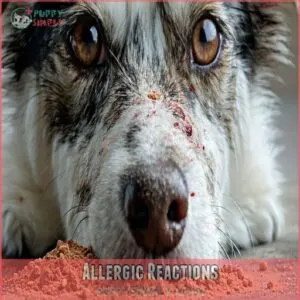This site is supported by our readers. We may earn a commission, at no cost to you, if you purchase through links.

The skin contains compounds that are tough to digest and could cause stomach upset or intestinal blockage.
Just like you wouldn’t eat a banana with the peel on, your four-legged friend shouldn’t munch on mango skin either.
Stick to feeding them peeled, bite-sized mango pieces as an occasional treat.
You’ll be surprised to learn about the creative ways you can serve this tropical fruit to make your dog’s tail wag with joy – safely and deliciously.
Table Of Contents
- Key Takeaways
- Can Dogs Eat Mango Skin?
- Are Mango Skins Toxic to Dogs?
- Benefits of Feeding Mango to Dogs
- Preparing Mangoes for Dogs
- Dangers of Feeding Mango Skins to Dogs
- Can Dogs Eat Mango Seeds or Pits?
- How to Introduce Mangoes Into Your Dog’s Diet
- Can Dogs Eat Dried or Canned Mango?
- Mango Recipes for Dogs
- Consulting With a Veterinarian
- Frequently Asked Questions (FAQs)
- Can dogs eat mango skin?
- Are there any side effects of eating mango skins?
- Can dogs eat mangoes?
- Can dogs eat mango stones?
- What happens if a dog eats a mango pit?
- Can dogs eat mango pips?
- Are mango skins toxic to dogs?
- Are any fruits toxic to dogs?
- Is mango skin digestible?
- Can dogs have peaches or mangoes?
- How much mango can puppies safely eat?
- Can diabetic dogs have mango as treats?
- Whats the best mango variety for dogs?
- Do different dog breeds react differently to mangoes?
- When is mango season best for dogs?
- Conclusion
Key Takeaways
- Don’t feed your dog mango skin as it’s hard to digest and can cause choking or intestinal blockages.
- You can safely give your dog small pieces of peeled, seedless mango as an occasional treat.
- Watch for signs of allergies or digestive issues when introducing mango to your dog’s diet.
- Always consult your veterinarian before adding new foods like mango to your dog’s regular meals.
Can Dogs Eat Mango Skin?
Regarding feeding your furry friend mangos, you might wonder about the skin.
While it might seem like a natural addition to their diet, mango skin can cause digestive issues and poses a choking hazard—so it’s best skipped.
Safety of Mango Skin
Curious about mango skin’s safety for dogs? It’s a bit like the wrapper on your favorite snack—best left aside.
Dogs struggle with mango skin digestion, which can lead to tummy troubles.
Although packed with fiber, skin allergies and skin toxicity are real concerns.
Keep it simple: peel, dice, and let Fido enjoy the juicy parts minus the risks!
Risks of Feeding Mango Skin
Think about how mango skin might seem harmless, but it can cause a few headaches for your pup.
When dogs eat mango skin, risks include:
- Digestive upset and tummy troubles
- Choking hazard due to its tough texture
- Skin irritation from potential residues
- Allergic reactions causing itchiness
- Intestinal blockage, which spells real trouble
Keep your dog’s health in the clear!
Nutritional Value of Mango Skin
While feeding mango skin to your pup could mean taking on some risks, there’s also a nutritional side worth unpacking.
Mango skins are packed with fiber, offering benefits for digestion, alongside antioxidants and Vitamin C that boost health—but be cautious.
Can dogs eat mango skin safely? It’s best to skip it altogether.
| Nutrient | Potential Benefit | Caution |
|---|---|---|
| Fiber | Digestive health | Hard to digest for dogs |
| Antioxidants | Skin health | No proven benefits for dogs |
| Vitamin C | Immunity boost | Not necessary for canines |
Are Mango Skins Toxic to Dogs?
You’ve probably wondered if feeding your dog mango skin is risky, and the truth is, it can be.
While not exactly toxic, mango skins are tough for dogs to digest and might lead to unpleasant symptoms like stomach upset or blockages—imagine trying to chew through a shoe, but less fun.
Potential Health Risks
Imagine this: a pesky mango skin could spell trouble for your furry friend.
Mango skins pose potential health risks such as:
- Digestive upset: Dogs can’t easily digest it, as it’s fibrous and stringy in texture, much like mango peel risks.
- Toxicity concerns: The skin might’ve harmful substances.
- Choking hazards: It can block airways.
- Intestinal blockages: Thick skins cause blockages.
So, it’s best to keep mango skin out of your pup’s diet.
Symptoms of Toxicity
You’ve got a worried pup? Watch for these signs of mango skin trouble: diarrhea, vomiting, or lethargy.
More serious symptoms, like seizures or respiratory distress, are less common but need immediate vet attention.
Remember, prevention is key! Keep mango skins away from your furry friend for a happy, healthy dog. A little precaution goes a long way – it’s better to be safe than sorry!
Treatment for Mango Skin Toxicity
If your dog ends up munching on mango skin, don’t panic. Here’s what to do:
- Monitor symptoms: Keep an eye out for signs of distress.
- Seek veterinary care: Contact your vet for advice.
- Home remedies: Consider mild digestive aids.
- Emergency protocols: Be ready to visit the vet if needed.
- Supportive treatment: Make sure your dog stays hydrated.
Stay calm and watchful!
Benefits of Feeding Mango to Dogs
If you’ve ever wondered whether mangoes could benefit your furry friend, you’re in luck!
Packed with fiber, vitamins, and antioxidants, mangoes are delicious but can also help support your dog’s digestion and overall health—just don’t let them steal the whole fruit bowl!
Nutritional Benefits
While pondering the risks of mango skins, let’s consider the nutritional perks of mangoes for dogs.
Mangoes are full of vitamins like A, B6, and E, which boost your dog’s health. They’re rich in fiber, aiding digestive health and providing antioxidant benefits.
| Nutrient | Benefit |
|---|---|
| Fiber content | Aids digestion |
| Vitamin A | Supports eye health |
| Vitamin B6 | Enhances brain function |
| Antioxidants | Fights free radicals |
Health Benefits
Mangoes aren’t just tasty treats; they pack a health punch for your dog.
Packed with vitamins, they support your dog’s immune system and keep their skin and coat shining like no other.
The antioxidants in mango skin help fight off nasty free radicals.
So, every mango slice you share is like a bite-sized boost to your furry friend’s health!
How Mangoes Support Dog Health
A mango can be your dog’s secret weapon for better health!
Rich in vitamins like A, B6, and E, these juicy treats aid digestion and boost the immune system.
Your furry friend will love the skin and coat benefits from the antioxidants.
Just skip the skin—it’s tricky for pups to digest, sticking to the fruit itself guarantees happy tails!
Preparing Mangoes for Dogs
When you’re preparing mangoes for your dog, it’s important to peel them and remove the big seed to guarantee safety.
Serving juicy mango chunks without the skin or seed lets you treat your pup to a delicious snack while avoiding potential hazards.
Washing and Peeling Mangoes
Everyone knows the importance of clean fruit, but for your furry friend, it’s especially important.
You’ll want to give that mango a good scrub before peeling.
Rinse it under cool water, gently rubbing the skin to remove any dirt or pesticides.
Then, peel the mango, making sure to remove all traces of skin, as you’d when preparing freeze-dried mango snacks, which can be a nutritious and healthy treat when done correctly.
- Imagine your pup’s tail wagging with excitement as you prepare their treat
- Picture the peace of mind knowing you’re giving them safe, clean fruit
- Feel the satisfaction of being a responsible pet parent
- Envision the joy of sharing a healthy snack with your four-legged friend
Removing The Seed
Now that you’ve peeled the mango, it’s time to tackle the seed.
This pit’s a real whopper, so don’t let your pup near it!
Grab a sharp knife and carefully cut around the seed.
It’s like skirting a boulder – you want to get as much flesh as possible without hitting the core.
Once you’ve freed the good stuff, toss that seed in the trash.
No ifs, ands, or buts about it!
Serving Mango to Dogs
Ready to treat your furry friend to a mango feast? Here’s how to serve up this tropical delight safely:
- Cube the mango flesh into bite-sized pieces
- Mix it with their regular food for a tasty surprise
- Freeze small chunks for a cool, enjoyable snack
- Use it as a high-value training treat
Remember, moderation is key. Too much of this sweet treat might upset your pup’s tummy. Start small and watch for any mango allergies. Your dog’s tail will be wagging in no time!
Dangers of Feeding Mango Skins to Dogs
You might think mango skin is harmless, but it’s actually a triple threat to your furry friend.
It can make your pup choke, block their intestines, or trigger an allergic reaction faster than you can say "fruit salad.
Choking Hazards
You’ve prepped that juicy mango, but hold your horses! Mango skins are a no-go for your furry friend.
They’re like slippery banana peels in your dog’s throat, posing a serious choking risk.
Imagine your pup trying to gulp down a tough, leathery piece – it’s not a pretty picture.
Stick to the flesh and keep those peels out of reach.
Your dog’s wagging tail will thank you for playing it safe!
Intestinal Blockages
While choking’s a clear danger, mango skins can cause sneaky trouble in your pup’s belly.
These tough peels don’t break down easily, potentially leading to intestinal blockages.
It’s like a traffic jam in your dog’s gut – nothing moves, and that’s bad news.
Here’s what you need to know about intestinal blockages:
- They can cause severe pain and discomfort
- Vomiting and loss of appetite are common signs
- Constipation or diarrhea might occur
- Lethargy and bloating are red flags
- Prompt vet care is essential if suspected
Allergic Reactions
Beyond blockages, mango skin can trigger allergic reactions in some dogs.
While it’s always a good idea to explore the benefits of hypoallergenic dog food to manage allergies, it’s wise to be aware of potential reactions to new foods.
Keep an eye out for itching, hives, or swelling – these are red flags.
Certain breeds might be more prone to mango allergies, so it’s wise to introduce it slowly.
If your pup shows any signs of discomfort, don’t panic!
Remove the mango and give your vet a ring.
It’s always better to be cautious regarding your furry friend’s health.
Can Dogs Eat Mango Seeds or Pits?
Now, let’s talk about those pesky mango seeds and pits.
You should absolutely never give your dog a mango pit; they contain amygdalin, which can release cyanide – definitely not a tasty treat!
Safety of Mango Seeds
Now, let’s talk about those pesky mango pits.
Ever wondered if your pup can munch on them?
It turns out that mango seeds aren’t the only pit that can be problematic – peach pits also contain amygdalin and can be toxic to dogs.
They’re not just a choking hazard; these little nuggets pack a punch with something called amygdalin.
It’s like nature’s own little danger packet.
Keep those pits far from Fido’s reach to avoid any tummy troubles or worse.
Risks of Feeding Mango Seeds
Mango seeds are a big no-no for your furry friend. These pits pack a punch of danger that’ll make any pet parent’s hair stand on end. Let’s break it down:
- Choking hazard: That pit’s a real troublemaker, potentially lodging in your pup’s throat.
- Intestinal blockage: If swallowed, it can cause a traffic jam in your dog’s gut.
- Cyanide poisoning: The seed’s amygdalin content is no laughing matter, and you can find more information about dog eat mango skin dog eat mango skin.
- Digestive issues: Even small bits can upset your dog’s tummy.
What to Do if Your Dog Eats a Mango Seed
Uh-oh! Your furry friend’s just swallowed a mango pit.
Don’t panic, but act fast.
Keep a close eye on your pup and watch for any signs of distress.
If they’re choking, try the Heimlich maneuver.
Otherwise, ring up your vet pronto.
They might suggest bringing your dog in for a checkup or X-ray.
Remember, prevention’s better than cure – always keep those pesky pits out of reach!
How to Introduce Mangoes Into Your Dog’s Diet
Introducing mangoes to your dog’s diet can be a tasty adventure, but you’ll want to start small and watch for any tummy troubles.
Think of it like teaching your pup a new trick – take it slow, use plenty of praise, and soon you’ll have a mango-loving pooch on your hands.
Portion Control
Let’s talk about getting the right amount of mango for your furry friend.
You want to treat your pup, but too much of a good thing can be a belly buster.
Here’s how to keep it just right:
- Start small – a cube or two for tiny pooches
- Medium dogs can handle a few more pieces
- Big breeds might enjoy up to 1/4 cup
- Stick to the 10% rule for treats
- Always remove the skin and pit
Remember, mango’s a treat, not a meal replacement.
Your dog’s waistline will thank you!
Monitoring for Adverse Effects
You’ll want to keep a watchful eye on your furry friend for the first 24 hours after introducing mango.
Watch for signs of digestive upset like vomiting or diarrhea.
If you notice any skin reactions, breathing issues, or unusual behavioral changes, that’s your cue to call the vet.
Just like humans, dogs can develop mango allergies, so trust your gut if something seems off – better safe than sorry!
Can Dogs Eat Dried or Canned Mango?
If you’re wondering whether to share that dried mango from your hiking trail mix with your pup, you’ll want to think twice since store-bought versions often contain added sugars and preservatives that aren’t safe for dogs.
While fresh mango can be a healthy treat for your furry friend, canned varieties are also off-limits due to their high sugar content and artificial sweeteners.
Safety of Dried Mango
Store-bought dried mango packs a sugar-loaded punch that your furry friend doesn’t need.
While fresh mango offers natural nutrients, dried versions come with their own set of concerns.
Here’s what you need to know:
- Natural dehydration preserves some nutrients
- Homemade dried mango gives you control
- Skip added sweeteners and preservatives
- Stick to small portions as special treats
Consider making your own dehydrated mango treats instead.
Risks of Feeding Store-bought Dried Mango
Checking those ingredient lists on dried mango packages might make your head spin.
Commercial dried mangoes often pack unwanted surprises like added sugar and preservatives that can upset your pup’s tummy.
The industrial dehydration process also concentrates sugars to levels that aren’t dog-friendly.
Think of it like candy – it’s best to skip these store-bought treats and stick to fresh mango instead.
Preparing Dried Mango for Dogs
Making your own dried mango treats for your pup beats the store-bought options hands down, and you can also explore products from mango skin dog stores like Mango Skin Dog Products.
Slice fresh, peeled mango into thin strips, pop them in a food dehydrator at 135°F for 12-14 hours, and voilà – you’ve got wholesome treats!
Keep portions tiny since dried mango packs more sugar punch than fresh.
Store your homemade goodies in an airtight container for up to three months.
Mango Recipes for Dogs
You’ll love treating your furry friend to these tasty and safe mango-based recipes that’ll have their tail wagging in no time.
Whether you’re looking for a quick frozen treat or a special homemade snack, we’ve got simple recipes that’ll make your pup feel like they’re dining at a five-star doggy restaurant.
Dehydrated Fruit Treats
A delightful way to treat your pup is with homemade dehydrated mango slices.
You’ll want to slice peeled, pit-free mango into thin strips and dehydrate them at 135°F for 6-8 hours.
Before you start, make sure to explore mango skin dog safe options for purchase at mango skin safe products.
When using fruits like plums, which can be toxic to dogs due to their cyanide-filled pits, keep these DIY fruit treats small and manageable for your dog’s size.
Remember to remove all traces of skin before dehydrating, and store your finished treats in an airtight container for up to two weeks.
Other Mango-based Treats
Your pup will go bananas for frozen mango bites on hot summer days!
Mix diced mango with plain yogurt in ice cube trays for a cool treat, or blend it into a tail-wagging mango-banana smoothie.
You can also pop plain mango chunks in the freezer or combine them with other dog-friendly fruits.
Just remember to keep portions small and always remove the skin first.
Homemade Mango Recipes
Let’s kick those store-bought treats up a notch with simple homemade mango recipes that’ll make your pup’s tail wag!
Blend fresh mango chunks with plain yogurt for cool frozen mango smoothie pops, or create mango yogurt bites by mixing diced mango with Greek yogurt and freezing in ice cube trays.
For a quick treat, freeze pure mango chunks for a cooling snack on hot days.
Consulting With a Veterinarian
You’ll want to chat with your vet before adding mangoes to your pup’s menu, just like you’d check with your doctor before trying that new trendy superfood.
Your vet knows your furry friend’s health history inside and out, so they’re the perfect person to give you the green light on whether mango treats are a good fit.
Importance of Consultation
While those mango treats sound tempting, checking with a vet first can save you both a world of worry.
Every pup’s different – from dietary needs to health conditions that might trigger food allergies in dogs symptoms, making mango a no-go.
Think of your vet as your furry friend’s personal food coach! They’ll help you dodge any potential allergies or weight issues, making sure those tropical treats stay tail-wagging good.
What to Discuss With Your Veterinarian
Before introducing mangoes to your pup’s diet, consider the safe fruits for dogs, such as honeydew and cantaloupe, and schedule a chat with your vet about mango allergies and safe fruit intake.
Bring up any pre-existing conditions, current dietary supplements, and individual dog needs that might affect digestion.
Think of your vet as your furry friend’s food coach – they’ll help create a plan that keeps your dog’s tail wagging and tummy happy.
Ensuring Your Dog’s Safety
Your chat with the vet shouldn’t end at the office!
Keep their number handy in your phone, and don’t hesitate to call if your pup shows any unusual reactions after eating mango.
Taking these extra steps can make all the difference in keeping your furry friend safe and healthy.
- Save your vet’s emergency contact info in multiple places
- Create a pet first-aid kit with basic supplies
- Document any reactions your dog has to new foods like mango
Frequently Asked Questions (FAQs)
Can dogs eat mango skin?
Like a tough leather jacket, mango skin isn’t safe for your furry friend.
Don’t let your pup eat it – the skin’s hard to digest and might contain harmful substances.
Stick to feeding peeled mango pieces.
Are there any side effects of eating mango skins?
Mango skins can cause digestive issues and choking hazards for your furry friend.
They’re tough to digest and might contain harmful substances.
It’s best to stick with peeled, fresh mango flesh instead.
Can dogs eat mangoes?
Dogs can enjoy fresh mango as a healthy treat!
Remove the pit and skin first, then serve small, bite-sized pieces.
The fruit provides vitamins and fiber, but don’t overdo it – moderation’s key.
Can dogs eat mango stones?
By telegram or carrier pigeon, here’s the scoop: you must never feed mango stones to your dog.
They contain cyanide-releasing compounds that’ll make your furry friend sick, and they’re a dangerous choking hazard.
What happens if a dog eats a mango pit?
If your dog swallows a mango pit, it’s a serious emergency requiring immediate vet care.
The pit can block their intestines and contains cyanide-releasing compounds.
Don’t wait – seek help right away!
Can dogs eat mango pips?
Like hidden poison in a golden treasure, mango pips contain harmful amygdalin that can release cyanide.
You’ll need to remove these dangerous seeds before sharing this tropical treat with your furry friend.
Are mango skins toxic to dogs?
Mango skins aren’t directly toxic to your dog, but they’re tough to digest and can cause choking or intestinal blockages.
You’ll want to peel mangos completely before sharing this sweet treat with your pup.
Are any fruits toxic to dogs?
You’ll need to keep your dog away from grapes, raisins, cherries, and avocados – they’re toxic and can be deadly.
Watch out for fruit pits too, as they contain dangerous compounds.
Is mango skin digestible?
Despite what your stomach might think, mango skin isn’t digestible for humans or dogs.
It’s tough, fibrous, and contains compounds that can be hard on your digestive system.
Best to peel and toss it.
Can dogs have peaches or mangoes?
Dogs can enjoy both peaches and mangoes in moderation.
Remove pits and skins to prevent choking.
Slice the fruit into small, bite-sized pieces.
These tasty treats offer vitamins and fiber, but don’t overdo it – too much can upset their tummy.
How much mango can puppies safely eat?
Here’s a bite-sized tip for puppy parents: Keep mango treats tiny!
Offer your furry friend no more than a teaspoon of diced mango per 10 pounds of body weight.
It’s a sweet rule of thumb for safe snacking.
Can diabetic dogs have mango as treats?
You’ll want to be cautious with mangoes for your diabetic pup.
While they’re not off-limits, their natural sugars can affect blood glucose.
Offer tiny pieces occasionally as special treats, but always check with your vet first.
Whats the best mango variety for dogs?
While there’s no "top dog" among mango varieties for pups, stick to ripe, sweet options like Tommy Atkins or Kent.
They’re easier to digest and tastier.
Remember, it’s not about the breed but how you prep it!
Do different dog breeds react differently to mangoes?
Different dog breeds don’t typically react differently to mangoes.
However, individual dogs may have varying tolerances.
Some might love ’em, others might turn up their noses.
Always introduce new foods slowly, watching for any tummy troubles or allergies.
When is mango season best for dogs?
When the sun’s blazing and juicy treats are in order, mango season’s a dog’s delight.
Ripe mangoes are perfect for your pup year-round, but they’re especially delicious during summer months.
Just remember, moderation’s key for your furry friend’s health.
Conclusion
Imagine this: your pup eyeing that mango skin like it’s a golden ticket.
But hold up! While the juicy flesh is a tasty treat, can dogs eat mango skin? Nope, it’s best to peel and pitch it.
Stick to serving small, skinless chunks of mango goodness.
Remember, moderation is key – too much of a good thing can lead to tummy troubles.
By following these tips, you’ll keep your furry friend’s tail wagging and their belly happy. Now go ahead, share that mango moment safely!



















